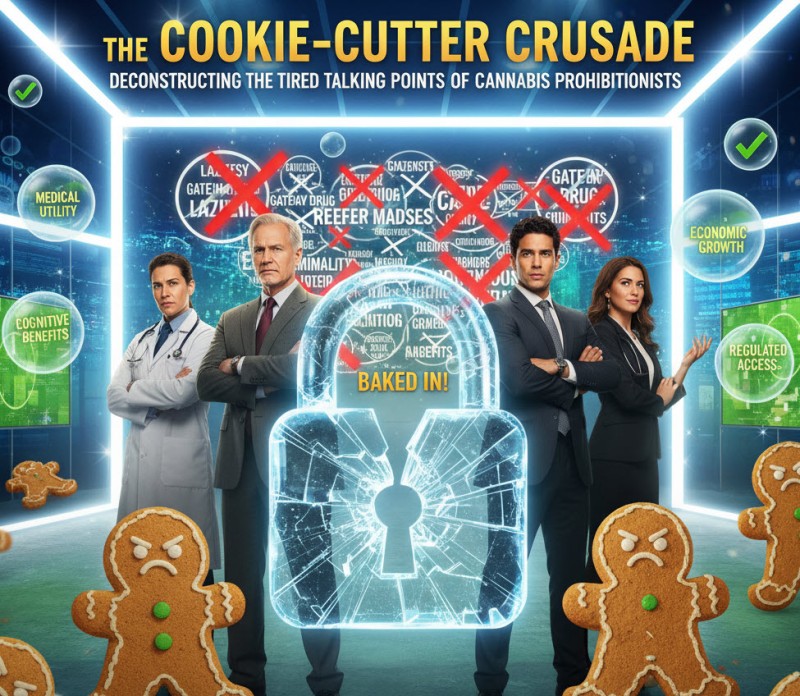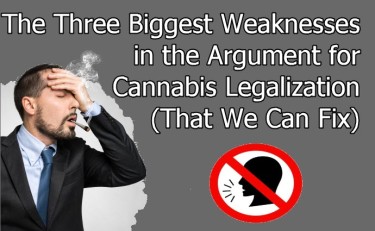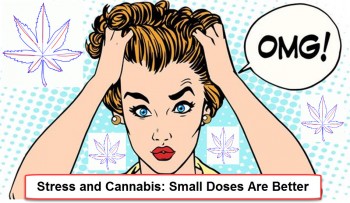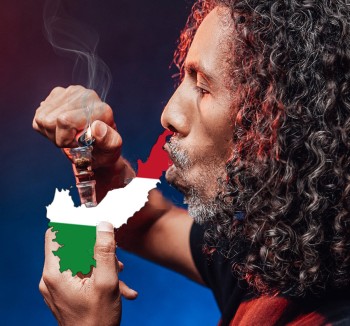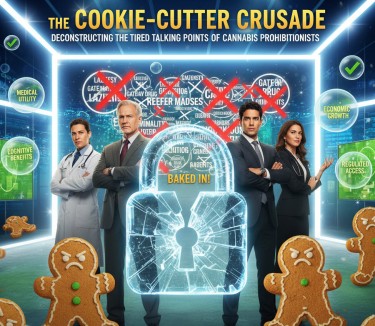
The Cookie-Cutter Crusade: Deconstructing the Tired Talking Points of Cannabis Prohibitionists
Here we go again, folks. Just when you think the cannabis prohibition debate might evolve beyond the same tired talking points from the 1980s, along comes the Concerned Women for America with their latest pearl-clutching manifesto on why marijuana should remain a Schedule I drug. Reading their recent piece felt like stepping into a time machine – one that's been stuck in reverse for about four decades.
What's fascinating about prohibitionist rhetoric isn't just its predictability, but its remarkable ability to contradict itself within the span of a few paragraphs. Take their latest article, where they simultaneously argue that the Controlled Substances Act isn't a "harm index" while immediately explaining how drugs are classified based on their potential for harm and abuse. It's like watching someone insist they're not wet while standing in the rain.
But here's what really gets me: the religious fervor behind these arguments. This isn't really about public health or safety – it's about ideology dressed up as policy. When an organization concludes their cannabis screed by asking people to "pray for the Administration," you know we've moved far beyond rational discourse into the realm of moral crusading.
The Concerned Women for America and their prohibitionist allies aren't just wrong about cannabis; they're weaponizing fear and misinformation to maintain a system that has demonstrably failed for over fifty years. Their arguments follow a predictable pattern: cherry-pick studies, ignore contradictory evidence, invoke "the children," and sprinkle in some good old-fashioned reefer madness for flavor.
Today, I want to take apart their arguments piece by piece, not because I enjoy intellectual demolition (though I do), but because these same talking points keep getting recycled by politicians, law enforcement, and advocacy groups who should know better. From their misunderstanding of what the CSA actually is, to their selective concern about addiction rates, to their historically ignorant claims about cannabis potency – we're going to address it all.
Buckle up, because we're about to dive deep into the mind of the modern prohibitionist, where cognitive dissonance reigns supreme and facts go to die.
The CSA: A Harm Index in Denial
The Concerned Women for America make a curious claim early in their piece: the Controlled Substances Act "is not a 'harm index' that indicates how dangerous a drug may be." This statement is so fundamentally wrong that it almost feels like satire. Let me explain why this is complete bullshit.
The CSA explicitly categorizes drugs based on two primary criteria: potential for abuse and accepted medical value. Both of these factors are direct measures of harm. "Potential for abuse" is literally an assessment of how harmful a substance can be to individuals and society. "Accepted medical value" determines whether the potential benefits outweigh the harms. If that's not a harm index, then I don't know what is.
But here's where their argument really falls apart: the legal consequences attached to each schedule directly reflect the perceived level of harm. Getting caught with a kilogram of a Schedule I substance like cannabis can result in 10 years to life in federal prison, with fines up to $10 million. Compare that to a Schedule III substance like ketamine, where the same amount might net you 5-10 years and up to $500,000 in fines. Schedule IV substances like Xanax? We're looking at up to 5 years and $250,000. Schedule V substances carry even lighter penalties.
These aren't arbitrary distinctions – they represent a sliding scale of perceived societal harm. The higher the schedule, the more "dangerous" the government considers the substance, and the harsher the punishment. To claim this isn't a harm index is to ignore the entire structure of federal drug law.
What makes this particularly infuriating is that the authors use this false premise to justify cannabis remaining in Schedule I. They argue that since it meets the "technical definition" of having high abuse potential and no FDA-approved use, it belongs there. But this circular reasoning ignores the fact that the FDA's approval process for cannabis has been deliberately obstructed for decades.
Consider the absurdity: the FDA has approved Epidiolex, a cannabis-derived medication containing CBD. They've also approved synthetic cannabinoids like Marinol and Syndros. Yet they maintain that the plant from which these compounds are derived has "no accepted medical use." It's like saying oranges have no nutritional value while selling vitamin C supplements derived from oranges.
This bureaucratic catch-22 is by design. The government has made it nearly impossible to conduct the research needed for FDA approval, then points to the lack of FDA approval as justification for continued prohibition. It's a perfect example of what I call "regulatory gaslighting" – creating impossible conditions, then blaming others for not meeting them.
The truth is, the CSA has always been a harm index with legal consequences. Pretending otherwise is either profound ignorance or deliberate deception. Given the stakes involved – millions of people criminalized, families destroyed, resources wasted – I'm inclined to believe it's the latter. The Concerned Women for America can clutch their pearls all they want, but they can't change the fundamental reality of what the CSA actually is.
The Addiction Fallacy: Cherry-Picking Statistics to Fit the Narrative
Let's talk about the elephant in the room that prohibitionists love to ignore: their selective outrage about addiction statistics. The Concerned Women for America breathlessly cite that "about 1 in 10 marijuana users develop a cannabis use disorder," treating this as some kind of smoking gun for why cannabis should remain Schedule I. But let's put this number in context, shall we?
One in ten. That's a 10% addiction rate. You know what else has roughly the same addiction potential? Alcohol. According to the National Institute on Alcohol Abuse and Alcoholism, about 10.5% of adults who drink alcohol will develop alcohol use disorder at some point in their lives. Yet somehow, the Concerned Women aren't calling for alcohol prohibition or demanding that Budweiser be classified as a Schedule I substance.
But here's where it gets really rich: tobacco, which isn't even listed on the Controlled Substances Act, has an addiction rate of 80-90%. That means if you try cigarettes, you have roughly a nine-in-ten chance of becoming addicted. Where's the moral panic about that? Where are the concerned women demanding that we schedule nicotine alongside heroin?
The silence is deafening because it exposes the fundamental hypocrisy of their position. They're not actually concerned about addiction rates or public health – they're selectively applying outrage to support a predetermined ideological position.
Let's also examine their claim about youth addiction rates. They note that when cannabis use begins before age 18, dependence rates jump to 1 in 6. Again, let's contextualize this. Early initiation of alcohol use also dramatically increases addiction risk, with some studies showing even higher rates of dependency among early alcohol users. The solution isn't prohibition – it's regulation and education.
What's particularly frustrating is how they frame cannabis dependency. The term "cannabis use disorder" encompasses a broad spectrum of behaviors, many of which wouldn't be considered problematic in other contexts. Someone who uses cannabis daily for chronic pain management might technically meet the criteria for "cannabis use disorder" even though their use is medically beneficial and doesn't impair their functioning.
This is fundamentally different from substances like opioids, where physical dependence develops rapidly and withdrawal can be life-threatening. Cannabis withdrawal, while real for heavy users, typically involves mild symptoms like irritability, sleep disturbance, and decreased appetite – hardly the stuff of medical emergencies.
The prohibitionists also conveniently ignore the concept of therapeutic use versus abuse. When someone uses cannabis to manage epilepsy, chronic pain, or PTSD symptoms, calling them "addicted" is like calling a diabetic "addicted" to insulin. The medical necessity and quality of life improvements don't factor into their black-and-white worldview.
Here's what the Concerned Women won't tell you: the vast majority of cannabis users – 90% by their own statistics – use it without developing any dependency issues whatsoever. They consume it responsibly, whether for medical or recreational purposes, and it doesn't negatively impact their lives. But acknowledging this reality would undermine their entire fear-based narrative.
The addiction argument isn't about genuine concern for public welfare – it's about maintaining prohibition through selective statistics and moral panic.
Prayers, Pearls, and Prohibition: The Religious Crusade Against Cannabis
By the end of their anti-cannabis manifesto, the Concerned Women for America reveal their true colors: "Let us pray for the Administration as it considers this important matter." There it is, folks – the admission that this isn't really about science, public health, or rational policy. This is a religious crusade masquerading as legitimate political discourse.
This is what I find most telling about modern prohibitionists: they're not evil masterminds with secret agendas to enrich pharmaceutical companies or maintain the prison-industrial complex. They're true believers, clutching their pearls and genuinely terrified that cannabis legalization will somehow corrupt their moral universe. They envision a world overrun by red-eyed hippies, reeking of weed and fornicating in the streets.
Here's the delicious irony: I actually agree with them that Schedule III is bullshit – just for the opposite reason. They want cannabis to remain Schedule I to maintain prohibition. I want it completely removed from the CSA because prohibition has been an unmitigated disaster for over fifty years.
The Concerned Women can pray all they want, but reality has a way of intruding on ideology. Cannabis legalization continues to spread state by state, not because of some mysterious "pro-weed lobby," but because people are seeing through the lies and experiencing the benefits firsthand.
Their cookie-cutter talking points might have worked in the 1980s, but today they sound like relics from a bygone era of ignorance and fear. The future belongs to evidence-based policy, not prayer-based prohibition.
The Cookie-Cutter Crusade: Deconstructing the Tired Talking Points of Cannabis Prohibitionists
Here we go again, folks. Just when you think the cannabis prohibition debate might evolve beyond the same tired talking points from the 1980s, along comes the Concerned Women for America with their latest pearl-clutching manifesto on why marijuana should remain a Schedule I drug. Reading their recent piece felt like stepping into a time machine – one that's been stuck in reverse for about four decades.
What's fascinating about prohibitionist rhetoric isn't just its predictability, but its remarkable ability to contradict itself within the span of a few paragraphs. Take their latest article, where they simultaneously argue that the Controlled Substances Act isn't a "harm index" while immediately explaining how drugs are classified based on their potential for harm and abuse. It's like watching someone insist they're not wet while standing in the rain.
But here's what really gets me: the religious fervor behind these arguments. This isn't really about public health or safety – it's about ideology dressed up as policy. When an organization concludes their cannabis screed by asking people to "pray for the Administration," you know we've moved far beyond rational discourse into the realm of moral crusading.
The Concerned Women for America and their prohibitionist allies aren't just wrong about cannabis; they're weaponizing fear and misinformation to maintain a system that has demonstrably failed for over fifty years. Their arguments follow a predictable pattern: cherry-pick studies, ignore contradictory evidence, invoke "the children," and sprinkle in some good old-fashioned reefer madness for flavor.
Today, I want to take apart their arguments piece by piece, not because I enjoy intellectual demolition (though I do), but because these same talking points keep getting recycled by politicians, law enforcement, and advocacy groups who should know better. From their misunderstanding of what the CSA actually is, to their selective concern about addiction rates, to their historically ignorant claims about cannabis potency – we're going to address it all.
Buckle up, because we're about to dive deep into the mind of the modern prohibitionist, where cognitive dissonance reigns supreme and facts go to die.
The CSA: A Harm Index in Denial
The Concerned Women for America make a curious claim early in their piece: the Controlled Substances Act "is not a 'harm index' that indicates how dangerous a drug may be." This statement is so fundamentally wrong that it almost feels like satire. Let me explain why this is complete bullshit.
The CSA explicitly categorizes drugs based on two primary criteria: potential for abuse and accepted medical value. Both of these factors are direct measures of harm. "Potential for abuse" is literally an assessment of how harmful a substance can be to individuals and society. "Accepted medical value" determines whether the potential benefits outweigh the harms. If that's not a harm index, then I don't know what is.
But here's where their argument really falls apart: the legal consequences attached to each schedule directly reflect the perceived level of harm. Getting caught with a kilogram of a Schedule I substance like cannabis can result in 10 years to life in federal prison, with fines up to $10 million. Compare that to a Schedule III substance like ketamine, where the same amount might net you 5-10 years and up to $500,000 in fines. Schedule IV substances like Xanax? We're looking at up to 5 years and $250,000. Schedule V substances carry even lighter penalties.
These aren't arbitrary distinctions – they represent a sliding scale of perceived societal harm. The higher the schedule, the more "dangerous" the government considers the substance, and the harsher the punishment. To claim this isn't a harm index is to ignore the entire structure of federal drug law.
What makes this particularly infuriating is that the authors use this false premise to justify cannabis remaining in Schedule I. They argue that since it meets the "technical definition" of having high abuse potential and no FDA-approved use, it belongs there. But this circular reasoning ignores the fact that the FDA's approval process for cannabis has been deliberately obstructed for decades.
Consider the absurdity: the FDA has approved Epidiolex, a cannabis-derived medication containing CBD. They've also approved synthetic cannabinoids like Marinol and Syndros. Yet they maintain that the plant from which these compounds are derived has "no accepted medical use." It's like saying oranges have no nutritional value while selling vitamin C supplements derived from oranges.
This bureaucratic catch-22 is by design. The government has made it nearly impossible to conduct the research needed for FDA approval, then points to the lack of FDA approval as justification for continued prohibition. It's a perfect example of what I call "regulatory gaslighting" – creating impossible conditions, then blaming others for not meeting them.
The truth is, the CSA has always been a harm index with legal consequences. Pretending otherwise is either profound ignorance or deliberate deception. Given the stakes involved – millions of people criminalized, families destroyed, resources wasted – I'm inclined to believe it's the latter. The Concerned Women for America can clutch their pearls all they want, but they can't change the fundamental reality of what the CSA actually is.
The Addiction Fallacy: Cherry-Picking Statistics to Fit the Narrative
Let's talk about the elephant in the room that prohibitionists love to ignore: their selective outrage about addiction statistics. The Concerned Women for America breathlessly cite that "about 1 in 10 marijuana users develop a cannabis use disorder," treating this as some kind of smoking gun for why cannabis should remain Schedule I. But let's put this number in context, shall we?
One in ten. That's a 10% addiction rate. You know what else has roughly the same addiction potential? Alcohol. According to the National Institute on Alcohol Abuse and Alcoholism, about 10.5% of adults who drink alcohol will develop alcohol use disorder at some point in their lives. Yet somehow, the Concerned Women aren't calling for alcohol prohibition or demanding that Budweiser be classified as a Schedule I substance.
But here's where it gets really rich: tobacco, which isn't even listed on the Controlled Substances Act, has an addiction rate of 80-90%. That means if you try cigarettes, you have roughly a nine-in-ten chance of becoming addicted. Where's the moral panic about that? Where are the concerned women demanding that we schedule nicotine alongside heroin?
The silence is deafening because it exposes the fundamental hypocrisy of their position. They're not actually concerned about addiction rates or public health – they're selectively applying outrage to support a predetermined ideological position.
Let's also examine their claim about youth addiction rates. They note that when cannabis use begins before age 18, dependence rates jump to 1 in 6. Again, let's contextualize this. Early initiation of alcohol use also dramatically increases addiction risk, with some studies showing even higher rates of dependency among early alcohol users. The solution isn't prohibition – it's regulation and education.
What's particularly frustrating is how they frame cannabis dependency. The term "cannabis use disorder" encompasses a broad spectrum of behaviors, many of which wouldn't be considered problematic in other contexts. Someone who uses cannabis daily for chronic pain management might technically meet the criteria for "cannabis use disorder" even though their use is medically beneficial and doesn't impair their functioning.
This is fundamentally different from substances like opioids, where physical dependence develops rapidly and withdrawal can be life-threatening. Cannabis withdrawal, while real for heavy users, typically involves mild symptoms like irritability, sleep disturbance, and decreased appetite – hardly the stuff of medical emergencies.
The prohibitionists also conveniently ignore the concept of therapeutic use versus abuse. When someone uses cannabis to manage epilepsy, chronic pain, or PTSD symptoms, calling them "addicted" is like calling a diabetic "addicted" to insulin. The medical necessity and quality of life improvements don't factor into their black-and-white worldview.
Here's what the Concerned Women won't tell you: the vast majority of cannabis users – 90% by their own statistics – use it without developing any dependency issues whatsoever. They consume it responsibly, whether for medical or recreational purposes, and it doesn't negatively impact their lives. But acknowledging this reality would undermine their entire fear-based narrative.
The addiction argument isn't about genuine concern for public welfare – it's about maintaining prohibition through selective statistics and moral panic.
Prayers, Pearls, and Prohibition: The Religious Crusade Against Cannabis
By the end of their anti-cannabis manifesto, the Concerned Women for America reveal their true colors: "Let us pray for the Administration as it considers this important matter." There it is, folks – the admission that this isn't really about science, public health, or rational policy. This is a religious crusade masquerading as legitimate political discourse.
This is what I find most telling about modern prohibitionists: they're not evil masterminds with secret agendas to enrich pharmaceutical companies or maintain the prison-industrial complex. They're true believers, clutching their pearls and genuinely terrified that cannabis legalization will somehow corrupt their moral universe. They envision a world overrun by red-eyed hippies, reeking of weed and fornicating in the streets.
Here's the delicious irony: I actually agree with them that Schedule III is bullshit – just for the opposite reason. They want cannabis to remain Schedule I to maintain prohibition. I want it completely removed from the CSA because prohibition has been an unmitigated disaster for over fifty years.
The Concerned Women can pray all they want, but reality has a way of intruding on ideology. Cannabis legalization continues to spread state by state, not because of some mysterious "pro-weed lobby," but because people are seeing through the lies and experiencing the benefits firsthand.
Their cookie-cutter talking points might have worked in the 1980s, but today they sound like relics from a bygone era of ignorance and fear. The future belongs to evidence-based policy, not prayer-based prohibition.
TALKING POINTS ABOUT CANNABIS, READ ON..
3 WEAK POINTS ABOUT CANNABIS LEGALIZATION AND HOW TO FIX THEM!
